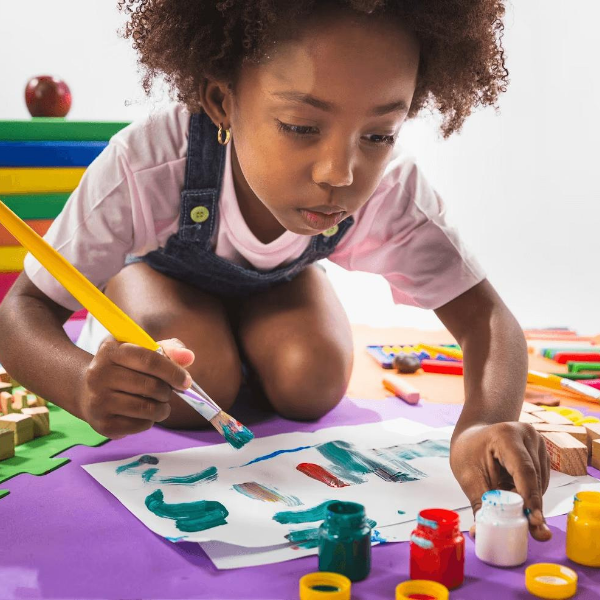
24 Tips for Extending Preschool Learning at Home
Young children are naturally curious, and their first few years are prime time for learning and development. They are like sponges, absorbing everything around them, so incorporating learning activities for preschoolers at home can be both fun and enriching. You don’t need to invest in expensive materials or become an early childhood education expert. You just need a bit of creativity, enthusiasm, and access to affordable, vetted resources. Read on for ideas to extend at-home learning for PreK kids, whether they’re enrolled in school or are being homeschooled.
Learn Through Play
According to the American Association of Pediatrics, “play is essential to development because it contributes to the cognitive, physical, social, and emotional well-being of children and youth. Play also offers an ideal opportunity for parents to engage fully with their children.” PreK kids love to pretend! Whether they’re pretending to be a fireman, a chef, a doctor or a superhero, this type of imaginative play is crucial for developing social and emotional skills. As a parent, you can support and enjoy pretend play with your child. Here’s how to get started:
- Set up themed play areas. Use household objects, existing toys, blankets and pillows to set up a store, a restaurant, a fire station, or a doctor’s office. Encourage your child to play and model some of the activities. For example, pour an imaginary cup of tea and offer it with the warning that it might be hot.
- Join in the game. Become a customer, a patient, or a person in need of rescue in the imaginary world. This not only makes playing more fun and helps you build a healthy, secure attachment with your child but also lets you practice wanted behaviors like problem solving, taking turns, and empathy.
- Emphasize social emotional learning. Talk to your child about the emotions they feel during the different scenarios of pretend play. Mindfulmazing is a great resource for helping your kid explore perspectives, understand their feelings, and build their emotional vocabulary.

Build Early Literacy through Story Time
One of the simplest ways you can encourage learning for kids at home is through reading. Story time is an excellent way to expand your preschooler’s vocabulary, develop listening and comprehension skills, and give wings to their imagination. Epic hosts a rich library of thousands of digital titles, both in e-book and audiobook format. To make the most out of reading with your PreK child, try the tips in this blog post and additional ones below:
- Go beyond the read-aloud. Make the experience interactive by asking your preschooler questions like, “What do you think this story is about,” “What do you think is going to happen next,” and “How do you think the character feels?” When you ask your child to think about what you read, you strengthen reading comprehension and critical thinking skills.
- Try multiple rereads. Encourage your child to “read” a familiar book back to you by looking at the pictures and recalling parts of the plot. Even if they don’t actually read the text, this activity is excellent for developing concepts of print, building memory, and practicing sequencing skills.
- Encourage your child to make their own stories. Just like pretend play, children are amazing at using their imagination and becoming immersed in self-created fiction. As Einstein once said, “Imagination is more important than knowledge. Knowledge is limited. Imagination encircles the world.” Building a story requires children to use their vocabulary, understand plot elements like problem and solution, and even learn early presentation skills. If your preschooler would benefit from additional speech and language support, check out Little Bee Speech in our resource library.
- Use books as the starting point for social studies. Teach preschoolers about community, identity, history and even early financial literacy. This will help nurture your preschooler into the citizen of tomorrow. This Ed2Grow blog post provides seven ideas for incorporating social studies learning at home.

Make Math Part of Every Day
When you think about including math in at-home learning activities for preschoolers, try to skip the worksheets. Math is all about real-life application, and it’s easy to incorporate early math concepts into your daily routine.
- Practice sorting and patterns: Invite your child to help you with laundry by separating pieces of clothing by color, size, or type. Clean up the playroom by sorting the stuffed animals by pets and wild animals, big or small, funny or serious – the sky is the limit for possible categories. You could even ask your preschooler to come up with their own groups and they will surprise you with their creativity.
- Count everything. Steps, stairs, stuffed animals, blocks, oranges in the bowl, unmatched socks or bites of broccoli – anything and everything can be counted. If you want a versatile learning tool dedicated to learning to count, sort and understand patterns, you can get the Wooden Montessori Number Blocks (affiliate link).
- Cook together. Cooking is fun, hands-on, and has delicious results. Pick easy recipes and involve your preschooler as much as possible. Let them measure, pour, and compare quantities – they will see that a teaspoon of salt is very different in size from a cup of flour.
- Hunt for shapes. Ask your preschooler to draw different shapes on a sheet of paper, then walk around your home, yard, or neighborhood and tally how many shapes you see. Make sure to name the shape every time you find one and keep a tally to practice counting.
- Find tools that work for you and your child. A great resource for visual Math activities at home for preschoolers is Didax, an app that offers various digital manipulatives to help home learning for preschoolers. Math Is Fun and Khan Academy are two other excellent options for extending math learning at home.
Develop Fine Motor Skills and Boost Creativity with Art
Arts and crafts are a ton of fun and a great way to work on those fine motor skills that are so important in early childhood development. You can easily find supplies for most early artistic projects in or around your home and the results make your young artist feel proud of their accomplishments. Here are some examples of artistic learning you can include in the daily schedule for your preschooler.
- Painting with a twist. Encourage your child to paint using various tools – sponges, leaves, Q-tips, spray bottles, feathers or fingers. On warm days, take art activities outside and let them try squirt gun or spray bottle painting.

- Make nature collages. Fall is an especially good season to collect leaves, flowers, and twigs, then arrange them paper and glue to create unique compositions. Check out more ideas for learning through outdoor play in this blog post.
- Create painted macaroni jewelry. This is a fun activity that helps build eye-hand coordination, an essential fine motor skill. Plus, you likely already have the materials at home!
- Try 21st century art mediums. Codable Crafts allows your child to animate stories with accessible drawing tools and coding blocks. Kids get a developmentally appropriate peek at computer programming principles while having fun animated stories using their own creations.
Discover the World of Science Exploration
Science is all around us and PreK children are excellent observers. You don’t need to build a lab in your kitchen to introduce science concepts to your preschooler. Tools like Stemfinity provide you and your child with the latest STEAM projects, lessons, and resources, but there are also plenty of ways to engage in science with materials you already have around the house. Try one of the easy activities and experiments below to spark an interest in the natural world.
- Engage in water play. Fill a container with water and ask your child to pick various household items. Then guess which items will float or sink. This introduces them to making and testing a hypothesis, making predictions, and noting results.
- Grow plants. There is no easier way to learn about living things, what they need, and how they grow and change than with plants. Have your PreK child water seedlings, make observations over time, and notice comparisons. This will also teach.
- Talk about and observe the weather. Encourage your preschooler to observe outside conditions. Keep a journal of changes with simple drawings or stickers, then discuss their ideas about what is happening and why. If you can, make a visit to your local weather station and talk to the staff about tools they use to collect data and predict the weather.
Extending Preschoolers’ Learning at Home
Incorporating learning activities for preschoolers at home offers a wonderful opportunity to support your child’s cognitive, social, and emotional development. With a little creativity, daily tasks and playful activities become rich learning experiences. Whether you’re homeschooling or supplementing formal education, fostering an environment of curiosity and engagement is key to helping your little one thrive. For more helpful ideas, don’t forget to subscribe to our newsletter! Stay updated with more tips, activities, and resources to make learning at home both fun and effective.
This blog post may include paid ads and as an Amazon Affiliate, Ed2Grow earns money from qualifying purchases.
